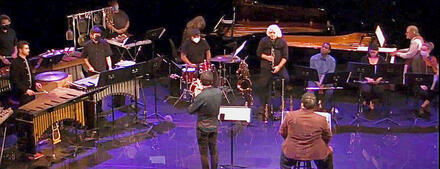Can other leaders perform premier American avant conceptualist Anthony Braxton's individualistic compositions? In the wake of Tri-Centric Foundation's ongoing "Braxton 75" initiative, Thumbscrew's 2020 "The Anthony Braxton Project" and other link-ups, the answer is "Hell yeah!"
The two halves of this REDCAT/CalArts presentation, spearheaded by alto saxist Steve Lehman, demonstrated that Braxton's creative charts can generate levels of excitement similar to plugging in the Xmas lights with wet fingers. But such a musical undertaking requires special-forces skill and coordination.
Lehman began the evening with a sextet comprising regional musicians of topmost ability. Upright bassist Mark Dresser, a past member of several Braxton ensembles, plumbed the heart of Braxton's intent with twin-handed effects, strange buzzes and railroad grooves. Trumpeter Jonathan Finlayson and tenor saxist Mark Turner tightly executed Braxton's fast unisons and harmonies, and soloed with enormous range, from edginess to sensuality. Lehman's cutting, ever-bending alto sound presented a stringent front voice. And the bouncing, challenging rhythm section of Dresser, drummer Jonathan Pinson and pianist Paul Cornish (the last devising a world from a few notes on "Composition 23e") really made the whole thing dance, no small accomplishment given the many hairpin twists in the melodic and rhythmic road. A raving bop/Ornette number wound the segment to a climax in a cocktail more shaken than stirred. We felt Braxton's quickness, his humor, his desire to help us rethink ourselves -- and also his constant desire to rethink himself.
After intermission, the lights came up on two grand pianos, two vibraphones, some percussion, some strings, some woodwinds and some brass . . . and in the middle, white-thatched longtime Braxton comrade Vinny Golia, surrounded by seven winds.
The concept of "a real-time collage of compositions" required not one but two cooperative conductors -- a centered Nicholas Deyoe and a darting Tim Feeney -- plus cue cards. Spontaneity was the word, and although Braxton had designed the charts to overlap, it was a revelation to watch it work.
Before the group interaction, pianists Vicki Ray and David Rosenboom launched into a frenetic, sprinkle-stabbing duet that seemed to diagram Braxton's entire math & science into a few exciting minutes, as Rosenboom raised hands like a diving hawk and tall Ray reached inward for precise, intelligent responses.
The orchestra was like a vast picnic, with Deyoe and Feeney opening the baskets and popping the bottles, the conversation rising to family squabbles and subsiding under the voice of reason, some members gathering here, some there, sometimes toasting all together in a glorious jamcounter. Textures, textures. On clarinets, saxes and alto flute, Golia represented the Greek Chorus, an objective focal point who could chatter with sibylline intensity or spin a folktale for the kids, maybe "Peter and the Wolf."
At the end, the camera seemed to pull back from the family scene, and we heard a darker context. Marching. Sounds of doom. Violent bashes. A sudden fade to quiet.
One of an artist's tasks is to express what we feel.
* * *
Thanks to Vinny Golia for advisory input.

